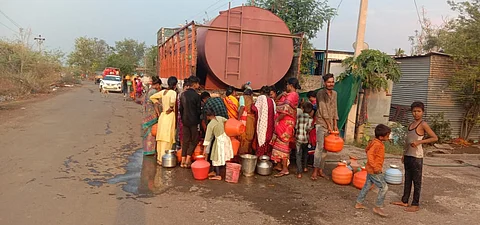

Marathwada, the central part of Maharashtra, is a catchword for water scarcity. Like most summers, this year too has seen Chhatrapati Sambhajinagar (formerly Aurangabad), Latur and Dharashiv (formerly Osmanabad), and five other districts of the region, experience water shortage, causing them to turn to water tankers.
Water shortage was still being reported at the end of June 2024, even though the southwest monsoon had reached the region.
In Chhatrapati Sambhajinagar district, 701 tankers were offering water to 73 hamlets and 443 villages as on June 21, 2024. All of them were private-owned. In Jalna, 481 tankers (471 of them private) were providing water to 92 hamlets and 316 villages.
In Beed, 347 tankers (345 of them private) were supplying water to 300 villages and 288 hamlets.
Parbhani district had 33 tankers, again all private, supplying water to 25 villages and seven hamlets. Hingoli had 10 tankers, eight of them private, providing water to five villages and five hamlets.
In Nanded, 31 private tankers provided water to 11 villages and 21 hamlets. Dharashiv had 108 private tankers supplying water to its 74 villages. Finally, 43 tankers (38 of them private) supplied water to 30 villages and 16 hamlets in Latur district.
There are several reasons as to why Marathwada is water deficient.
It is, first and foremost, a rain shadow region. The Western Ghats take in much of the moisture and precipitation provided rain-bearing winds from the Arabian Sea. The region thus receives less rain traditionally, than Konkan on the other side of the Ghats.
Other reasons include decreasing forest cover, more evaporation due to increasing heat intensity as a result of climate change and farming of sugarcane, a water-intensive crop.
Rainfall in the region has become irregular due to climate change. It may not rain for days. When it does rain, a huge amount falls within a very short period.
“Due to climate change and deforestation, there is more than 100 millimetres of rainfall in a day now. But the soil is not able to absorb all the water,” agricultural meteorologist Nakul Harwadikar of Krishi Vigyan Kendra, Tuljapur in Dharashiv district, told Down To Earth (DTE).
This year, Khamgaon in Beed district recorded 200 mm of rainfall in one night, according to Harwadikar. Now, whenever it rains for even one hour, water is not absorbed properly, leading to scarcity, he added.
Sugarcane production is also causing a decline in the water table. An example of this is Latur district. Drought and low rainfall in 2013, 2014, 2015 and 2016 caused groundwater levels to drop.
The district also has the highest area under sugarcane production. There are 20 sugar mills in the district.
Because of record water extraction from borewells and wells as well as irregular rainfall, the groundwater level has reduced from 0.11 to 4.60 metres (m).
“Latur and Dharashiv districts receive water from two earthen dams — Terna on the Terna river and Manjara on the Manjara river. These dams usually supply water for nine months of the year. But now, due to increasing heat, the water in both bunds evaporates very fast. This is creating a lot of problems, especially for farmers,” Amar Patil, executive engineer from the state water resources department told DTE.
A glance through official data shows that Patil is right. From July 2023 till March 2024, 1.2617 million cubic metres of water evaporated from the Terna Dam, while 1.918 million cubic metres evaporated from the Manjara Dam.